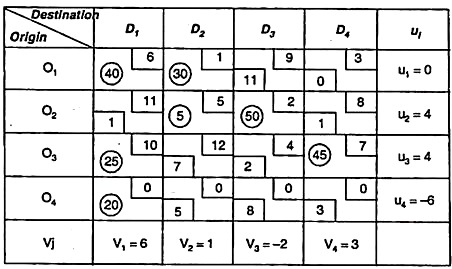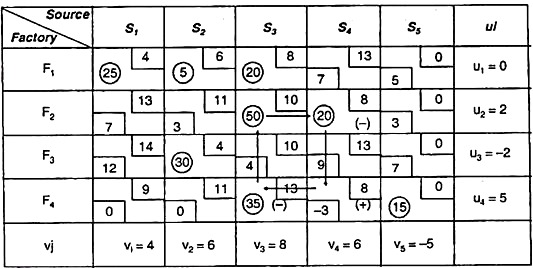After reading this article you will learn about balanced and unbalanced transportation problem.
Balanced Transportation Problem:
For a transportation problem:
Subjected to constraints
x11 for all i and j is said to be balanced transportation problem when total supply from all the sources is equal to the total demand in all destinations, otherwise, problem is said to be unbalanced transportation problem.
A transportation problem may have feasible solution only it is a balanced problem. An unbalanced problem can be made balanced by adding dummy supply centre (row) or dummy demand centre as per the requirement.
Unbalanced Transportation Problem:
ADVERTISEMENTS:
If in a transportation problem, the sum of supply available from all sources is not equal to the sum of demands of all destinations, i.e. the problem is said to be unbalanced transportation problem.
But for a feasible solution to exist, total supply must be equal to the total demand thus it is necessary to convert these unbalanced T.P. into balanced one.
There are two possibilities:
Supply is in excess than the demand, we introduce a dummy demand centre (additional destination column) to the transportation problem to absorb the excess supply. The unit transportation cost for the cells of this dummy destination column are all set equal to zero, because these represents item that are not being made and sent.
Working Rule:
Whenever i.e. total demand exceeds total supply, we introduce a dummy supply centre (additional supply row) in the transportation problem to meet extra demand. The unit transportation cost for the cells of its dummy row are set equal to zero.
Example of Second Type:
Solve the transportation problem when the unit transportation costs, demand and supplies are as given below.
Solution:
ADVERTISEMENTS:
Since the total demand ∑bj = 215 is greater than the total supply ∑ ai = 195 the problem is an unbalanced T.P.
We convert this into a balanced T.P. by introducing a dummy origin 04 with cost zero and giving supply equal to 215 – 195 = 20 units. Hence we have the converted problem as follows.
As this problem is balanced there exists a feasible solution to this problem. Using least cost method we get the following initial solution:
There are 7 independent non – negative allocation equals to m + n— 1. Hence, the solution is a non – degenerate one.
The total transportation cost
= (6 x 65) + (5 x 1)+(30 x 5)+(25 x 2)+(4 x 25) + (7 x 45) +(20 x 0)
= Rs. 1010
To find the optimal solution:
We apply the steps in MODI method to the above table.
First of all we calculate u1 vj & Δij.
using the relation cij = ui + vj for occupied cells
and Δij = cij – ( ui+ vj) for unoccupied cells.
Since all Δij is not greater or equal to zero then solution is not optimum.
... We introduce the cell (O3, D1) as this cell has most negative value of Δij, Hence this cell is selected to be brought into basis.
For cell O3 D1 we construct closed path as follows
O3D1→O3D3→O2D3→ O2D2→O1D2→ OxD1→O1D1→O3D3
We assign (+) and minus (-) alternately on the closed path starting (+) for the selected all O2D1, and adjusting relevant supplies/demand position, the revised allocation will be following table.
As the no of independent allocations are equal to m + n – 1, we check the optimality for this we again calculate ue uj & Δij.
Example of First type:
A product is produced by four factories F1, F2, F3 and F4. Their unit production cost are Rs 2, 3, 1 and 5 respectively. Production capacity of the factories are 50, 70, 30 and 50 units resp. The product is supplied to 4 stores S1, S2, S3, and S4, the requirements of which are 25, 35, 105 and 20 resp. Unit cost of transportation are given below.
Find the transportation plan such that the total production and transportation cost is minimum.
Solution:
We form the transportation table which consists of both production and transportation. costs.
This table is as follows:
Where total cost = unit cost of production + transportation cost
Hence the problem is unbalanced. We convert it into a balanced one by adding a dummy store S5 with cost 0 and the excess supply is given as the rim requirement to this store namely (220 — 185) =15 units
To find initial basic feasible solution:
The initial basic feasible solution is obtained by least cost method, and we have found following initial basic feasible solution.
The initial basic feasible solution containing m + n – 1=8 non-negative independent allocation. So the solution is non – degenerate solution.
The total transportation cost
= (4 x 25)+(6 x 5)+(8 x 20)+(10 x 50)+ (8 x 20)+ (4 x 30) +(13 x 35) + (15 x 0)
= Rs. 1525
To find the optimal solution:
For this we apply MODI method to the above table as it has m + n – 1 independent non – negative allocation for this first we calculate ui, vj and Δij with following relation
Cij = ui + vj for occupied cell
Δij = cij – (ui + vj) for unoccupied cell
This solution is not optimum since cell (F4, S4) is having a negative net evaluation value i.e. Δ44 = -3
Then we draw a closed path from the cell and have a modified allocation by adding and subtracting min = (35,20) = 20.
This closed path is F4S4 → F4S3 → F2S4 → F2S4 → F4S4
This modified allocation is given in the following table:
Again we have check optimality for the again we calculate ui, vj & Δij.
Since all values of Δij ≥ o the solution is optimum.
The optimum solution is






















